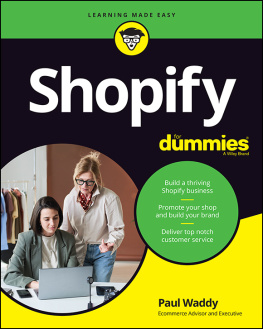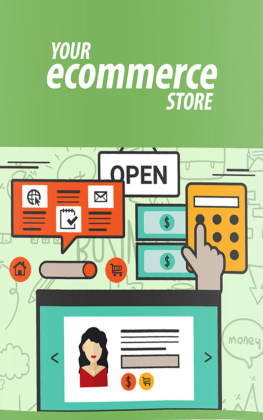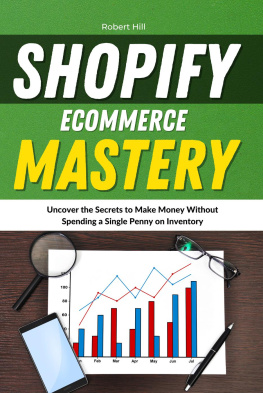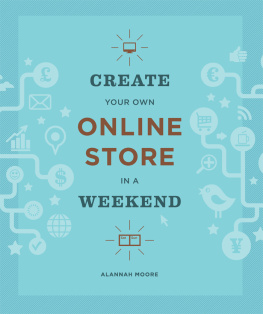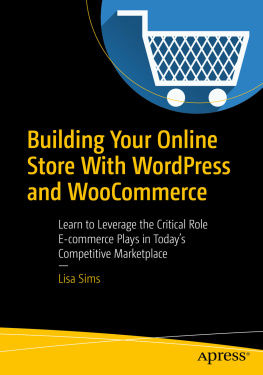Selling on Shopify: How To Create an Online Store & ProfitableeCommerce Business with Shopify
Brian Patrick
Published by GrassRoot Books atSmashwords
Copyright 2014 Brian Patrick
Table of Contents
-
-
-
-
-
-
-
-
-
-
-
-
-
-
-
-
-
-
-
-
-
-
-
-
-
-
-
-
-
-
-
-
-
-
-
-
-
-
-
-
-
Introduction
By 2017, retail sales involving theInternet, such as direct eCommerce transactions or as part of aconsumers research, will account for around 60% of retail sales inthe U.S. according to a report by Forrester Research Inc. named theU.S. Cross-Channel Retail Forecast, 2012 To 2017.
Additionally, within 5 years, retail salesmade online will almost double from the 5.2% in 2013 to a projected10.3% (or, $3.6 trillion in eCommerce sales as compared to $370billion)
The days of shopping in brick and mortarstores are noticeably diminishing. Retail commerce is quicklybecoming an online experience, and this outcome stems from bothmore informed, empowered consumers AND retailers.
Consumers are now armed with mobile devicesstoring their banking and credit card information so purchases canbe made instantly. Consumers have mobile applications designedspecifically for comparing prices across all retail stores, bothoffline and online, and these comparisons include thousands ofproduct reviews from fellow consumers.
Retailers can no longer afford to neglectthe wealth of information and technology that their consumerspossess. Companies are shifting their resources to meet theircustomers fast moving demands for a better online shoppingexperience. This includes everything from making their onlinestores more customized for mobile devices, to the creation ofe-coupons, to integrating social activity such as Facebook likes into their product listings.
In the previous two decades (1990-2010),only those companies who could afford to venture online did andnow, these first movers are more than making up for their riskyventure into eCommerce, in terms of market share and revenue.
In the past, retailers would have to hirelarge web development firms to build out their online retailtechnology. With both consumers and projections favoring this shifttowards online shopping experiences, more retailers began demandingimproved eCommerce technology and due to this demand, a whole newindustry has developed.
Innovative tech and software companiesappealing to this demand have begun creating one-size-fits-allsoftware and solutions for retailers across all product categories.These innovations have made it affordable for retailers to meet thenew-age demands of their consumers, providing an online shoppingexperience that their current customers will utilize and futurecustomers will prefer over the brick and mortar experience.
So what does this mean for you?
Well, as a consumer, expect to see acontinued shift in retailers catering to your needs through a moreintegrated, online experience - online storefronts, mobileapplications, e-coupons, free shipping incentives online, and soforth.
However, you did not grab this book tolearn how this shift towards eCommerce will enhance your experienceas a consumer.
No.
You realized that because of this shift, newopportunities have arisen within the retail sector and theseopportunities are not only accessible to large corporations andretailers like before.
In the past, one needed a commercial retailspace, mass inventory, employees, and financing just to enter theretail business. These were considerable barriers to entry, andonly those with tons of capital or those willing to risk it allcould join the game.
These barriers to entry are almostcompletely diminished and are no longer prerequisites for venturinginto the eCommerce landscape. Today, almost anyone looking to enterthe eCommerce industry can wielding only the little capital ittakes to operate a Shopify store and the drive to setup and run theonline store (which has a very short learning curve).
Selling Online 101
The influx of innovation within the onlineretail space has lead to the creation of a variety of platforms andonline store solutions for retail businesses and entrepreneurs.This has overwhelmed many of those looking to start selling online,and this ultimately leads to inaction.
Youve most likely grabbed a copy of thisbook because you have decided that you will be using Shopify tocreate your online store. Both grabbing this book and selectingShopify for your online store platform were sound decisions!
If Shopify is new to you, dont worry youwill quickly learn how Shopify will not only meet your onlineselling needs, but far exceed them.
In this section, we will briefly explore allof the available options for those looking to sell online and thenwell discuss why Shopify is the best solution for most onlinesellers.
Selling on a Third-PartyMarketplace
The easiest, and thus most common way tobegin selling online is through a third-party marketplace.Third-party marketplaces such as Amazon, Ebay, and Etsy allowsellers to list and sell their products directly from these onlinestores, rather than from their own store.
For example, an electronics storeowner cancreate a seller account on Amazon, which would allow him/her toupload their inventory and make it available for sale on Amazon.Tens of thousands of retailers currently utilize third-partymarketplaces to sell inventory online, many opting to only usethird-party marketplaces to sell their products rather thancreating their own online store.
Using a third-party marketplace can be veryprofitable for many sellers and this is because the marketplacedoes a lot of the heavy lifting for you. They provide you with thestorefront to use, handle taking/processing all the orders, andeven market your product to their customers.
Pros of Selling via Third-PartyMarketplaces
Quick Setup Process Can be up and running almostimmediately.
Low/No fixed Costs - Only pay commission to the marketplace after asale is made, a low monthly fee, or both.
Ease of PaymentProcessing Payment is usually processedthrough the marketplaces own payment processer or third-partyprocessor, such as PayPal, making getting paid an easyprocess.
Increased Visibility &Access to Established Customer Base Marketplaces want to help market your products because for everysale you make, they get paid their commission.
Cons of Selling via Third-PartyMarketplaces
Marketplace Keeps YourCustomers You make the sale, but themarketplace keeps buyers contact information and will sell themother sellers products that may or may not be yours.
Paying Commissions Usually you will pay anywhere between 7-16% ofthe sale price depending on the marketplace and categorization ofproduct.
Heavy Competition There are tens of thousands of competingsellers, with many of the sellers having access to the sameinventory. This leads to a decrease in pricing, direct pricing warswith other sellers, and thus, only the long established retailersthat can operate with small profit margins remain profitable in thelong run.
No Control of CustomersExperience - You can only control limitedaspects of your products listings. Also, most marketplaces dontallow or make it hard to offer discounts, coupon codes, and othertypes of promotions that would help you generate sales.
Not Creating Your OwnBusiness/Brand You are helping to buildthe brand of the marketplace and not your own. This makes it veryhard to develop a longstanding business and/or sell the businessbecause the customers arent truly yours and you cannot market newproducts to them in the future.
Should You Use Third-Party Marketplaces?
Next page


